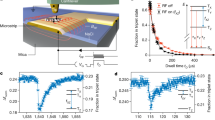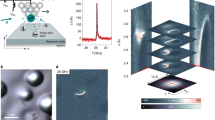Abstract
Magnetic resonance imaging (MRI) is well known as a powerful technique for visualizing subsurface structures with three-dimensional spatial resolution. Pushing the resolution below 1?µm remains a major challenge, however, owing to the sensitivity limitations of conventional inductive detection techniques. Currently, the smallest volume elements in an image must contain at least 1012 nuclear spins for MRI-based microscopy1, or 107 electron spins for electron spin resonance microscopy2. Magnetic resonance force microscopy (MRFM) was proposed as a means to improve detection sensitivity to the single-spin level, and thus enable three-dimensional imaging of macromolecules (for example, proteins) with atomic resolution3,4. MRFM has also been proposed as a qubit readout device for spin-based quantum computers5,6. Here we report the detection of an individual electron spin by MRFM. A spatial resolution of 25?nm in one dimension was obtained for an unpaired spin in silicon dioxide. The measured signal is consistent with a model in which the spin is aligned parallel or anti-parallel to the effective field, with a rotating-frame relaxation time of 760?ms. The long relaxation time suggests that the state of an individual spin can be monitored for extended periods of time, even while subjected to a complex set of manipulations that are part of the MRFM measurement protocol.
This is a preview of subscription content, access via your institution
Access options
Subscribe to this journal
Receive 51 print issues and online access
$199.00 per year
only $3.90 per issue
Buy this article
- Purchase on Springer Link
- Instant access to full article PDF
Prices may be subject to local taxes which are calculated during checkout




Similar content being viewed by others
References
Ciobanu, L., Seeber, D. A. & Pennington, C. H. 3D MR microscopy with resolution 3.7?µm by 3.3?µm by 3.3?µm. J. Magn. Reson. 158, 178–182 (2002)
Blank, A., Dunnam, C. R., Borbat, P. P. & Freed, J. H. High resolution electron spin resonance microscopy. J. Magn. Reson. 165, 116–127 (2003)
Sidles, J. A. Folded Stern-Gerlach experiment as a means for detecting nuclear magnetic resonance in individual nuclei. Phys. Rev. Lett. 68, 1124–1127 (1992)
Sidles, J. A. et al. Magnetic resonance force microscopy. Rev. Mod. Phys. 67, 249–265 (1995)
DiVincenzo, D. P. Two-bit gates are universal for quantum computation. Phys. Rev. A. 51, 1015–1022 (1995)
Berman, G. P., Doolen, G. D., Hammel, P. C. & Tsifrinovich, V. I. Solid-state nuclear-spin quantum computer based on magnetic resonance force microscopy. Phys. Rev. B 61, 14694–14699 (2000)
Stowe, T. D. et al. Attonewton force detection using ultrathin silicon cantilevers. Appl. Phys. Lett. 71, 288–290 (1997)
Chui, B.W. et al. Mass-loaded cantilevers with suppressed higher-order modes for magnetic resonance force microscopy. Technical Digest 12th Int. Conf. on Solid-State Sensors and Actuators (Transducers'03) 1120–1123 (IEEE, Piscataway, 2003).
Stipe, B. C. et al. Electron spin relaxation near a micron-size ferromagnet. Phys. Rev. Lett. 87, 277602 (2001)
Mozyrsky, D., Martin, I., Pelekhov, D. & Hammel, P. C. Theory of spin relaxation in magnetic resonance force microscopy. Appl. Phys. Lett. 82, 1278–1280 (2003)
Berman, G. P., Gorshkov, V. N., Rugar, D. & Tsifrinovich, V. I. Spin relaxation caused by thermal excitations of high-frequency modes of cantilever vibration. Phys. Rev. B 68, 094402 (2003)
Hannay, J. D., Chantrell, R. W. & Rugar, D. Thermal field fluctuations in a magnetic tip—implications for magnetic resonance force microscopy. J. Appl. Phys. 87, 6827–6829 (2000)
Mamin, H. J., Budakian, R., Chui, B. W. & Rugar, D. Detection and manipulation of statistical polarization in small spin ensembles. Phys. Rev. Lett. 91, 207604 (2003)
Castle, J. G., Feldman, D. W., Klemens, P. G. & Weeks, R. A. Electron spin-lattice relaxation at defect sites: E′ centers in synthetic quartz at 3 kilo-Oersteds. Phys. Rev. 130, 577–588 (1963)
Albrecht, T. R., Grütter, P., Horne, D. & Rugar, D. Frequency modulation detection using high-Q cantilevers for enhanced force microscope sensitivity. J. Appl. Phys. 69, 668–673 (1991)
Slichter, C. P. Principles of Magnetic Resonance, 3rd edn, 20–24 (Springer, Berlin, 1990)
Berman, G. P., Kamenev, D. I. & Tsifrinovich, V. I. Stationary cantilever vibrations in oscillating-cantilever-driven adiabatic reversals: Magnetic-resonance-force-microscopy technique. Phys. Rev. A. 66, 023405 (2002)
Berman, G. P., Borgonovi, F., Goan, H.-S., Gurvitz, S. A. & Tsifrinovich, V. I. Single-spin measurement and decoherence in magnetic-resonance force microscopy. Phys. Rev. B 67, 094425 (2003)
Brun, T. A. & Goan, H.-S. Realistic simulations of single-spin nondemolition measurement by magnetic resonance force microscopy. Phys. Rev. A. 68, 032301 (2003)
Davenport, W. B. & Root, W. L. An Introduction to the Theory of Random Signals and Noise 104 (McGraw-Hill, New York, 1958)
Ting, M., Hero, A.O., Rugar, D., Yip, C.-Y. & Fessler, J.A. Electron spin detection in the frequency domain under the interrupted oscillating cantilever-driven adiabatic reversal (iOSCAR) protocol. Preprint at http://xxx.lanl.gov/abs/quant-ph/0312139 (2003).
Manassen, Y., Hamers, R. J., Demuth, J. E. & Castellano, A. J. Direct observation of the precession of individual paramagnetic spins on oxidized silicon surfaces. Phys. Rev. Lett. 62, 2531–2534 (1989)
Durkan, C. & Welland, M. E. Electronic spin detection in molecules using scanning-tunneling-microscopy-assisted electron-spin resonance. Appl. Phys. Lett. 80, 458–460 (2002)
Wrachtrup, J., von Borczyskowski, C., Bernard, J., Orritt, M. & Brown, R. Optical-detection of magnetic resonance in a single molecule. Nature 363, 244–245 (1993)
Köhler, J. et al. Magnetic resonance of a single molecular spin. Nature 363, 242–244 (1993)
Jelezko, F. et al. Single spin states in a defect center resolved by optical spectroscopy. Appl. Phys. Lett. 81, 2160–2162 (2002)
Elzerman, J. M. et al. Single shot read-out of an individual electron spin in a quantum dot. Nature (in the press)
Jiang, H.-W., Xiao, M., Martin, I. & Yablonovitch, E. Electrical detection of electron spin resonance of a single spin in the SiO2 of a Si field effect transistor. Nature (in the press)
Rugar, D., Yannoni, C. S. & Sidles, J. A. Mechanical detection of magnetic resonance. Nature 360, 563–566 (1992)
Acknowledgements
We thank J. Sidles, A. Hero, M. Ting, G. Berman, I. Martin, C. S. Yannoni and T. Kenny for discussions, and D. Pearson, Y. Hishinuma, M. Sherwood and C. Rettner for technical assistance. This work was supported by the DARPA Three-Dimensional Atomic-Scale Imaging programme administered through the US Army Research Office.
Author information
Authors and Affiliations
Corresponding author
Ethics declarations
Competing interests
The authors declare that they have no competing financial interests.
Supplementary information
Supplementary Video
This animated movie illustrates the cantilever-driven spin inversions that occur during the iOSCAR spin manipulation protocol (see Fig. 2 in the paper). The “Lock” and “Anti-lock” states correspond to the spin being either aligned or anti-aligned with respect to the effective field in the rotating frame, resulting in either positive or negative cantilever frequency shifts, respectively. Each time the microwave field is interrupted, the spin switches between the locked and anti-locked states and the phase of the spin inversions with respect to the cantilever motion is reversed. (MP4 933 kb)
Rights and permissions
About this article
Cite this article
Rugar, D., Budakian, R., Mamin, H. et al. Single spin detection by magnetic resonance force microscopy. Nature 430, 329–332 (2004). https://doi.org/10.1038/nature02658
Received:
Accepted:
Issue Date:
DOI: https://doi.org/10.1038/nature02658
This article is cited by
-
Broadband stripline Lenz lens achieves 11 × NMR signal enhancement
Scientific Reports (2024)
-
Three-dimensional magnetic resonance tomography with sub-10 nanometer resolution
npj Quantum Information (2024)
-
Single-molecule electron spin resonance by means of atomic force microscopy
Nature (2023)
-
Single-electron spin resonance detection by microwave photon counting
Nature (2023)
-
Coherent optical two-photon resonance tomographic imaging in three dimensions
Communications Physics (2023)
Comments
By submitting a comment you agree to abide by our Terms and Community Guidelines. If you find something abusive or that does not comply with our terms or guidelines please flag it as inappropriate.



